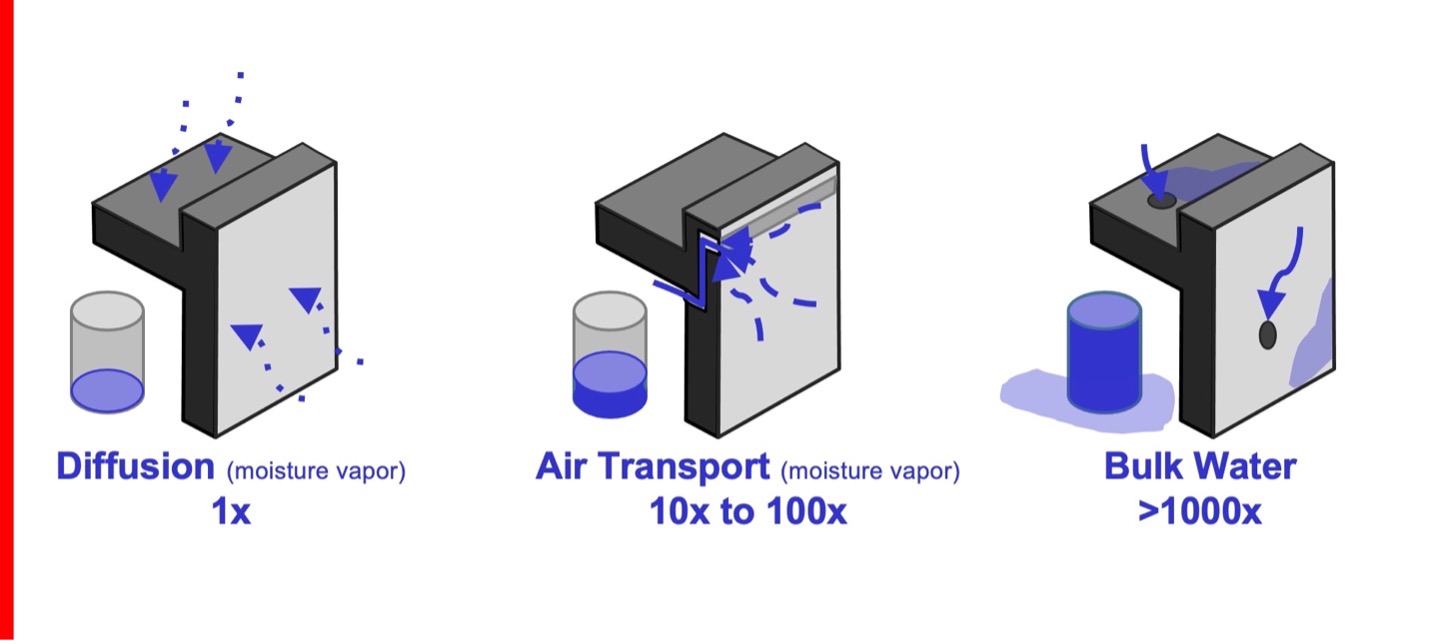High-Performance Cold Storage Roof Design
Air leakage versus vapor diffusion
Because of the comparative amount of moisture transported during each process, air-transported moisture is a larger issue than vapor diffusion. The National Research Council Canada collected research data that illustrated how even small openings can dramatically affect overall air leakage performance.1 For example, air can transport up to 100 times more moisture than the process of diffusion. This illustrates the greater impact that air leakage can have over moisture accumulation from vapor diffusion, which can have a significant negative impact on cold storage facilities. Air leakage can form ice or icicles on the underside of roof decks or within the roofing assembly, all of which impact the energy use and operations within the cold storage facility.

Relative moisture risks.
Most commonly in cold storage structures, the roof membrane serves as the vapor retarder and the air barrier. Accordingly, it is critical that the membrane be continuous, with no gaps or holes. The membrane should be designed and installed to block the passage of air by detailing all laps, penetrations, and the roof-to-wall interfaces. Any discontinuities within the assembly will lead to condensation within the roof assembly or at the interior of the cold storage facility.
Section 3: Cold Storage Design
There are many factors that may affect roof design, including specific jobsite conditions, local building codes, and building use, all of which must be taken into account to achieve desired energy savings and efficient operations. Due to the nature of cold storage buildings and the need to maintain specific interior temperatures, designing the best roofing system for the building becomes more than material selection. Proper design and installation will impact the functionality of the roof assembly for the life of the roof, which could be 20 years or more.
Cold Storage—General design considerations
Proper roofing system design and selection involves careful consideration of factors specific to cold storage. These help to provide a fundamentally sound basis for design and selection. First, verify during design that proposed materials are compatible with each other and that they will achieve the end goals of the project, such as energy efficiency and mitigation of air movement.
Section 4: Roofing Assembly Design in Cold Storage Buildings
A successful building system is greater than the simple sum of its parts. That is especially true for buildings facing challenging performance issues, like cold storage buildings. Material selection is extremely important, but how the entire system interacts and reinforces itself is of equal weight. Given their unique thermodynamic needs, a cold storage building should have an uninterrupted, continuous building envelope. That envelope should provide adequate levels of insulation to maintain interior temperature and minimize thermal loss as well as control air and vapor intrusion across the envelope. Material selection as part of a roofing assembly will determine how effective the roof will perform over the life of the roof system.
Ultimately, a cold storage building should have an uninterrupted, continuous building enclosure with these attributes:
- Adequate amounts of insulation.
- Appropriate attachment to maintain interior temperatures and minimize thermal loss.
- Control of air and water vapor movement.
- Design that anticipates low interior temperatures, the resulting vapor drive, and significant potential for air infiltration. This includes proper detailing to prevent air infiltration or exfiltration at enclosure transitions and penetrations.
Vapor retarders
The climate in which a cold storage building is located is a factor in determining where to install the vapor retarder. As discussed previously, in most locations for most times of the year, the interior of the building will be colder than the exterior. Therefore, the most effective place for a vapor retarder is at the exterior of the roofing assembly, which most often is the roofing membrane. Most roof membranes are Class I vapor retarders; perm ratings for single-ply membranes range from 0.03 to 0.06 perms. The lower the perm rating, the less diffusion of water vapor that occurs through a material. It is important to note that these are material ratings; the full system needs to be designed and installed correctly for proper functionality.









